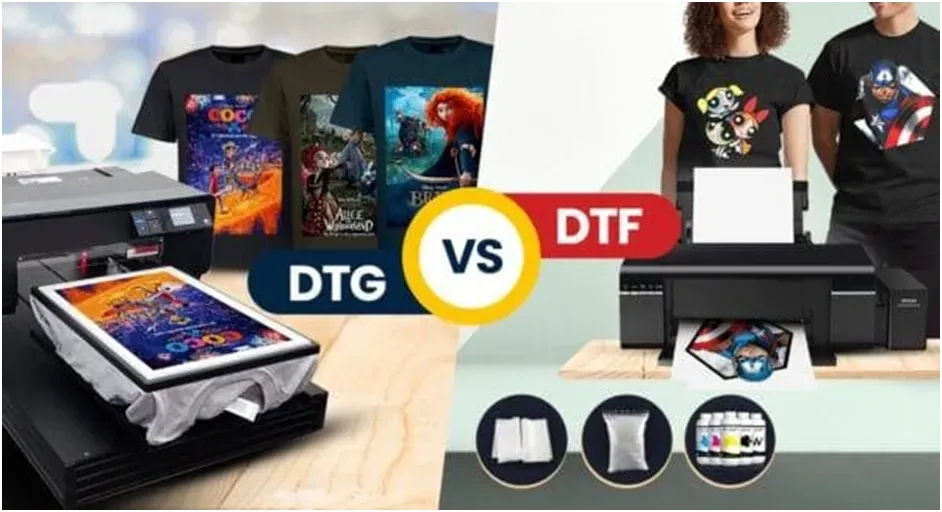The debate of DTF vs. DTG is pivotal for anyone in the apparel printing industry, as both methods showcase unique advantages and features. Direct to Film (DTF) and Direct to Garment (DTG) offer distinct approaches to custom clothing printing, catering to different needs and preferences. With DTF printing highlighting its sustainability and versatility, while DTG printing focuses on high-resolution detail, understanding the nuances of each technique is vital for informed decisions. This comparison will explore the effectiveness of sustainable printing methods and their implications for businesses looking to produce high-quality designs. Whether you’re a seasoned printer or just stepping into the world of apparel printing, grasping the differences between DTF and DTG will enhance your strategic choices in custom clothing printing.
When selecting a printing process for your garment needs, understanding DTF and DTG can make all the difference. The terminology behind these methods—Direct to Film and Direct to Garment—reflects their core operational differences in applying designs to fabric. While DTF promotes eco-friendly practices and is adaptable to various materials, DTG excels in delivering superior detail mainly on cotton fabrics. This article delves into these innovative techniques within the realms of sustainable printing methods, comparing how each caters to the demands of modern apparel production. By examining the pros and cons, this guide offers insights to help you determine the best fit for your custom apparel projects.
Understanding DTF Printing: Key Features and Benefits
Direct to Film (DTF) printing is revolutionizing the world of custom clothing printing. This method involves printing designs onto a specialized film, which are then transferred onto various fabrics under heat and pressure. Unlike traditional screen printing, DTF allows for vibrant colors and intricate details, making it ideal for dynamic designs that capture attention. Furthermore, DTF has emerged as a sustainable option in apparel printing, significantly minimizing waste by requiring fewer resources and generating less off-cut fabric.
One of the standout features of DTF printing is its ability to work on a broad spectrum of fabrics, including cotton, polyester, and fabric blends. This versatility opens up new possibilities for businesses looking to cater to diverse customer preferences. Additionally, DTF technology utilizes white ink, enhancing print quality on darker materials where DTG printing might fall short. Such capabilities not only expand the range of products a business can offer but also ensure that customers receive high-quality items that stand out in the market.
Exploring DTG Printing: Advantages and Limitations
Direct to Garment (DTG) printing is known for its exceptional quality and high-resolution detail when printing on cotton fabrics. Utilizing advanced inkjet technology, DTG allows for designs to be printed directly onto garments, producing prints that are soft to the touch and feel integrated into the fabric. This makes DTG the preferred choice for intricate artwork and complex designs that require fine lines and gradient colors, providing superior visual appeal for custom clothing.
However, it’s important to note that DTG printing is primarily effective on natural fabrics, particularly cotton. This limitation restricts options for businesses looking to produce apparel using synthetic fibers or blends, which are increasingly popular in today’s fashion trends. Additionally, while DTG offers great detail, it can be less efficient for bulk orders due to longer production times compared to DTF. Understanding these pros and cons is vital for businesses when choosing the appropriate printing method for their specific needs.
DTF vs. DTG: The Environmental Impact
When it comes to sustainability in printing, DTF solves many of the challenges posed by conventional methods. This approach is designed to minimize waste and reduce harmful emissions, aligning closely with modern demands for environmentally friendly production practices. As brands navigate the shift towards sustainable printing methods, DTF emerges as a preferred choice, showcasing a commitment to responsible manufacturing without compromising on quality or efficiency.
In contrast, DTG printing, while offering high-quality results, does not always meet the same environmental benchmarks as DTF. The ink consumption and water usage involved in the DTG process can lead to higher levels of waste. However, advancements in technologies for DTG are also promoting the development of eco-friendly inks and processes. Businesses must weigh these sustainability aspects when deciding on a printing method, as consumers increasingly favor brands that prioritize the planet.
Cost Efficiency: Evaluating DTF and DTG
Cost-effectiveness is a crucial factor when evaluating printing methods for businesses. DTF printing shines in this regard, especially for larger production runs. The process involves lower ink consumption and significantly less waste, resulting in more cost-efficient production of custom clothing items. This affordability makes DTF appealing for companies aiming to produce high volumes without compromising on print quality.
On the other hand, while DTG may be seen as less cost-effective for larger orders, it offers a fantastic option for small-batch prints and custom designs. With its user-friendly operation, many small businesses find that DTG is easier to set up and manage for bespoke items or limited edition collections. As businesses assess DTF vs. DTG, understanding these cost factors helps align printing capabilities with financial goals and market demand.
Market Trends: The Rise of DTF in Apparel Printing
The landscape of apparel printing is continuously evolving, and DTF is quickly gaining traction. As more businesses recognize the importance of sustainability and versatility in printing methods, DTF’s adoption is on the rise. Companies like DTF San Antonio exemplify this growth, making strides to cater to the increasing demand for eco-conscious printing solutions. This trend indicates that DTF is not just a passing phase; it represents a fundamental shift in how apparel is produced.
Moreover, the versatility of DTF extends beyond just fabric compatibility; it also accommodates a wide array of design options, making it ideal for customizing various apparel items. From t-shirts to tote bags, the potential for creative expression is vast, driving interest among consumers who seek unique products. As this trend continues to grow, businesses looking to expand their service offerings would do well to consider integrating DTF technology into their printing operations.
Choosing Between DTF and DTG: Making Informed Decisions
Deciding between DTF and DTG printing requires a thorough understanding of your specific needs and goals. For those focused on eco-friendly practices and versatility across fabric types, DTF may emerge as the superior choice. Its ability to produce vibrant prints on a range of materials positions it as an attractive option for businesses aiming to appeal to environmentally conscious consumers.
Conversely, businesses that prioritize high detail and quality on cotton fabrics may still findDTG to be the most appealing option. The results speak for themselves, with DTG providing a soft, high-resolution finish that enhances the overall product experience. Ultimately, the choice between DTF and DTG should reflect the unique objectives of a business, allowing for well-informed decisions that align with brand values and market expectations.
Frequently Asked Questions
What are the main differences between DTF printing and DTG printing?
DTF printing (Direct to Film) and DTG printing (Direct to Garment) are two popular methods in custom clothing printing. DTF printing uses a special film to transfer designs onto various fabrics, making it more versatile for different materials. In contrast, DTG primarily prints directly onto cotton garments, excelling in high-detail prints but struggling with synthetic fabrics. While DTF is more sustainable and efficient for bulk orders, DTG offers unmatched print quality on cotton.
Is DTF printing more sustainable than DTG printing?
Yes, DTF printing is often considered more sustainable than DTG printing. DTF methods generate less waste by utilizing special films for transfers, allowing for eco-friendly practices. This reduction in waste aligns with the growing trend of sustainable printing methods, appealing to environmentally conscious brands and consumers seeking eco-friendly apparel production.
Can DTF printing be used on all types of fabrics?
Certainly! One of the key advantages of DTF printing is its compatibility with a wide range of fabrics, including cotton, polyester, and blends. This versatility allows businesses and individuals to create custom clothing printing solutions for diverse materials, unlike DTG printing, which is primarily effective on cotton.
Which printing method, DTF or DTG, is better for high-resolution designs?
For high-resolution designs, DTG printing has the edge. DTG employs advanced inkjet technology that allows ink to penetrate the fabric, resulting in soft prints with exceptional detail. However, DTF printing can still achieve impressive quality, especially with its ability to print on various fabrics, but may not match the detail level you can achieve with DTG on cotton garments.
What are the cost implications of using DTF vs. DTG printing for bulk orders?
DTF printing typically offers better cost efficiency for bulk orders due to lower ink usage and reduced waste. This makes DTF printing a favorable option for businesses looking to produce larger quantities of custom apparel. In comparison, while DTG printing is suitable for small runs and custom orders, it can be less cost-effective for larger quantities due to higher ink costs and production time.
Which printing method is easier to operate for beginners, DTF or DTG?
DTG printing is generally easier to operate for beginners. The setup and operation of DTG systems are more straightforward, making it an appealing choice for small businesses or those new to custom clothing printing. However, DTF printing is also becoming more user-friendly as technology advances, but it may require additional steps in the transfer process.
| Aspect | DTF Printing | DTG Printing |
|---|---|---|
| Printing Process | Prints onto a special film then transfers onto fabric using heat and pressure. | Directly prints designs onto garments, mostly on cotton fabrics using inkjet technology. |
| Environmental Impact | More eco-friendly with less waste, appealing to sustainability-focused consumers. | Less sustainable as it primarily focuses on cotton fabric with higher waste. |
| Fabric Compatibility | Compatible with a variety of fabrics including cotton, polyester, and blends. | Best suited for cotton fabrics; limited effectiveness on synthetics and blends. |
| Print Quality | Produces vivid colors and intricate designs; white ink use enhances on dark fabrics. | Offers high-resolution prints with soft finish; excellent for detailed artwork. |
| User-Friendliness | Requires specialized equipment and training; becoming more accessible as technology evolves. | Typically easier to operate, ideal for small businesses and customized orders. |
| Production Speed | Efficient for larger bulk orders due to lower ink usage. | Ideal for small runs; slower production for bulk orders than DTF. |
| Cost Effectiveness | More cost-effective for larger orders due to efficiency and lower waste. | Better suited for smaller, custom runs but can be less efficient in larger volumes. |
Summary
In the battle of DTF vs. DTG, understanding the strengths and weaknesses of each printing method is crucial for businesses looking to achieve the best results. DTF printing excels in terms of sustainability and versatility, making it suitable for a wider range of fabrics and appealing to environmentally conscious consumers. On the other hand, DTG printing offers exceptional detail and quality, especially for cotton-based designs. As both printing technologies continue to evolve, making informed decisions based on specific needs will help businesses target their audiences effectively and enhance their printing capabilities in a competitive market.



